Rommel plays with Minatures for D Day
https://www.youtube.com/watch?v=rRuzjs9T_dw&t=29s
On this day during W.W. 2
-
Wishing everyone here a Merry Christmas!

-
Sweetness !
-
January 3, 1941. Eastern Front
German command problems continue on 3 January 1942 as the Red Army counteroffensive broadens. Already, two army group commanders and numerous generals such as Heinz Guderian have been sacked. The generals now are fighting over retaining control over units which the OKH and Hitler want to be transferred between commands. General Georg-Hans Reinhardt, commander of 3rd Panzer Army, refuses an order from General Adolf Strauß at Ninth Army, who has been given control over 3rd Panzer Army. The situation in Army Group Centre always has had these ad hoc commands, where one army is given command of another, but Reinhardt is upset about the refusal of Strauß to give him command over V Panzer Corps, which had been transferred to his sector. Army Group Centre commander Field Marshal Guenther von Kluge finally has to threaten Reinhardt with a court-martial if he does not obey Ninth Army’s orders. This is a prime example of the diva-ish behaviour that regularly breaks out within the upper ranks of the Wehrmacht.
Soviet troops are advancing on Rzhev, which had been far behind the front lines a few weeks ago. The Luftwaffe manages to operate despite -40 °F temperatures and flies in a battalion of reinforcements. The Germans have requisitioned winter clothing from the local inhabitants and learned ways to keep their machine guns and other automatic weapons working. This gives them a fighting chance to hold Rzhev, which is an important railhead and the entrance to the “land bridge” to Moscow.
Further south, Junkers Ju 87 Stukas of StG 77 attack Soviet shipping off the Kerch Peninsula. They bomb and badly damage Soviet cruiser Krasnyi Kavkaz. It is under repair until October 1942. On land, the Germans begin building up forces for a counterattack along a line about 10 miles west of Feodosia while the Soviet 51st, which has occupied the entire Kerch Peninsula, begins moving slowly west to reinforce the 44th Army. General Erich von Manstein, commander of 11th Army, sends 30 Corps under the command of Generalmajor Maximilian Fretter-Pico and also two other divisions from the Sevastopol perimeter to buttress the new line in the east. The Germans plan a counterattack as quickly as possible but it will take a couple of weeks to launch.
Source: worldwartwodaily
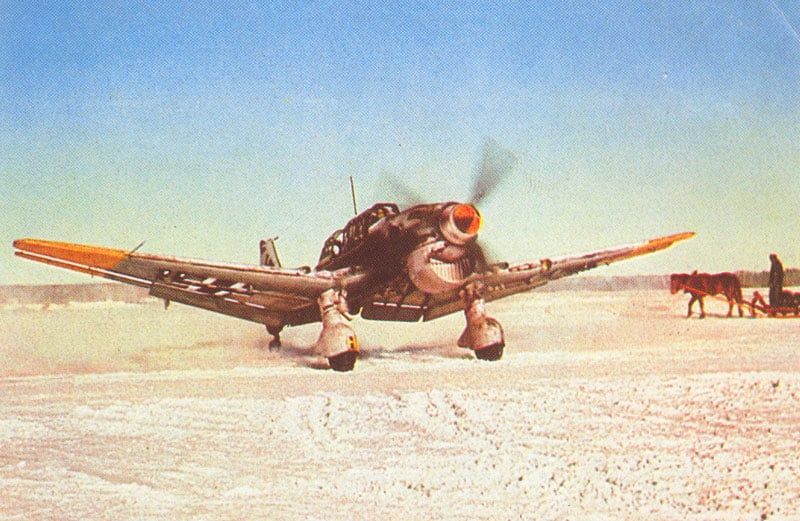
-
Awesome !!!
-
@captainwalker Love the pic.
-
January 7, 1942. Eastern Front
The Soviet General Offensive begins as scheduled on 7 January 1942. North of Lake Ilmen, Soviet 4th and 52nd Armies and 2nd Shock Army (now under the command of Lieutenant General Andrei A. Vlasov) of Volkhov Front attack southwest of Leningrad. On the southern part of Lake Ilmen, ski troops and motor convoys of Soviet 11th Army cross the frozen lake while German outposts watch from the opposite shore. The Red Army attacks are not strong, but the defending German 16th Army does not have a continuous line but instead a chain of isolated strongpoints. The German generals quickly decide that the 11th Army thrust is the most dangerous because it threatens Staraya Russa, the main German supply depot for the entire region. Nothing appears too dangerous to them at the moment, but there are wide gaps in the German lines with no troops behind them for dozens of miles. Things could get difficult for the Germans, but it all depends on where the Red Army units head and how far they decide to go. The Battle of Moscow is generally defined to end on 7 January 1942 due to the Soviet offensive.
Source: worldwartwodaily

-
January 8th 1940 - Finland
Details of the Finnish victory over two Russian Divisions at Suomussalmi were released. The 44th Division was completely destroyed, trapped while going to the support of the defeated 163rd Division. The Finns captured 102 field guns, 43 tanks, over 300 vehicle and 1,170 horses.
On the night of 8th January in Helsinki the Church bells were ringing, flags were flying and strangers embraced on the streets in celebration.
Many Soviet tanks were burnt-out by Molotov cocktails thrown by Finns hiding in pits by the forest tracks, other Soviet troops froze to death with nothing to protect them from the cold except crude shelters of spruce branches.
When the Finns attacked some of the Soviet troops were too weak to stand, too cold to fight.
Picture shows Finnish soldiers preparing to tow a Soviet flamethrower tank OT-130. The OT-130 tank was based on the T-26 tank chassis, with the 45 mm gun replaced with a flamethrower.
-
January 9, 1942. Eastern Front
200 miles northwest of Moscow, Soviet Northwest Front is fully engaged. 3rd and 4th Shock Armies (hastily-assembled, poorly-trained troops with little equipment, ammunition or food) cross the icy marshes of Lake Seliger in waist-deep snow. 4th Shock, attacking southwest towards Andreapol, is decimated by German machineguns at Peno but sheer weight of numbers overcomes the Germans. 3rd Shock Army fails to make progress attacking west towards Kholm. Further north, Soviet 11th Army approaches the town of Staraya Russa, defended by the experienced but exhausted German 18th Motorised Division, resting after the battles at Tikhvin.
Source: worldwar2daybyday
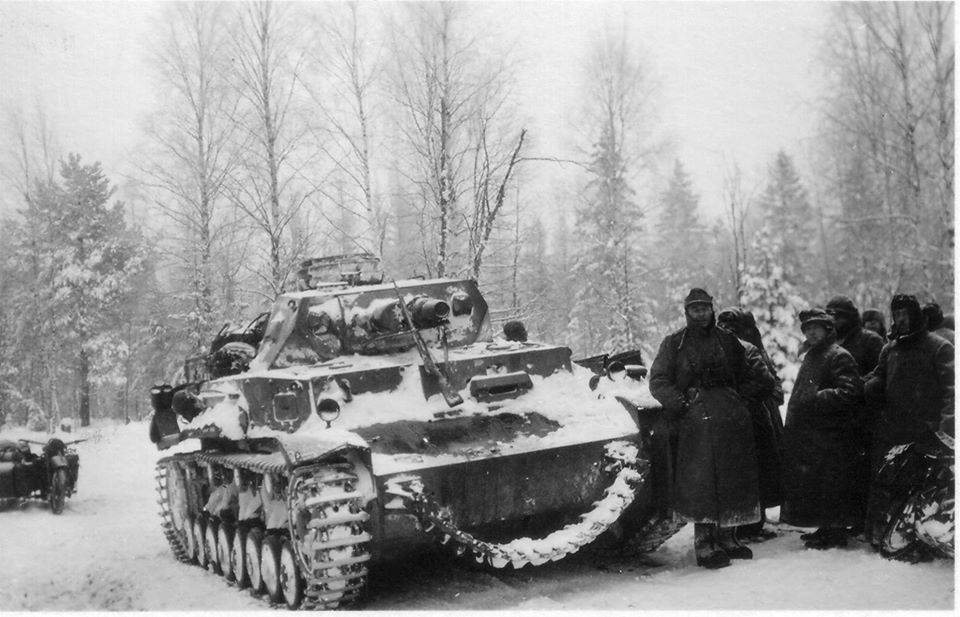
-
January 12, 1945. On the Eastern Front, Stalin launches the Vistula-Oder Offensive earlier than originally planned. Soviet forces attack with over 2,000,000 men, 4,500 tanks, 2,500 assault guns and 5,000 aircraft.

-
January 19, 1942. Eastern Front
The Soviet counteroffensive around Moscow continues unabated, with the Red Army capturing Mozhaisk about 100 km west of Moscow. This had been a key Red Army position during Operation Typhoon. In addition, Soviet paratroopers continue landing south of Smolensk in the Vyazma area. Their goal is to distract enough German troop strength from the front to help Red Army attacks further east and also to organise partisan forces. 225 miles northwest of Moscow, 3rd and 4th Shock Armies continue widening and deepening the gap between German Army Group North and Army Group Centre. 4th Shock Army continues it progress southwest towards Toropets while 3rd Shock Army aims west for Kholm having overcome initial German resistance.
In the Crimea, the German 30 Corps’ attack toward the Parpach Narrows continues with growing confidence. The German troops pursue two divisions of Soviet 44th Army east along the Black Sea Coast in the Feodosia area, undermining the Red Army defensive line just to the north. The main Soviet advantage is that the Parpach Narrows offers a shortened defensive line where the Red Army may be able to stop the advancing Germans.
Source: worldwartwodaily and worldwar2daybyday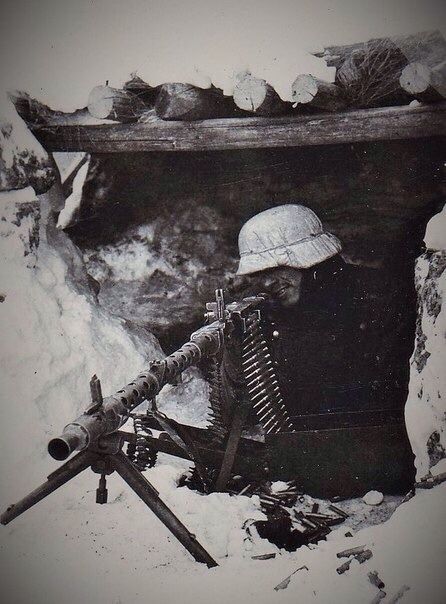
-
U-123 (Kptlt. Reinhard Hardegen, shown here in January/February 1942, was the first U-boat operating off the east coast of the United States as part of Operation Drumbeat. On 25 January 1942, it sinks British freighter Culebra.
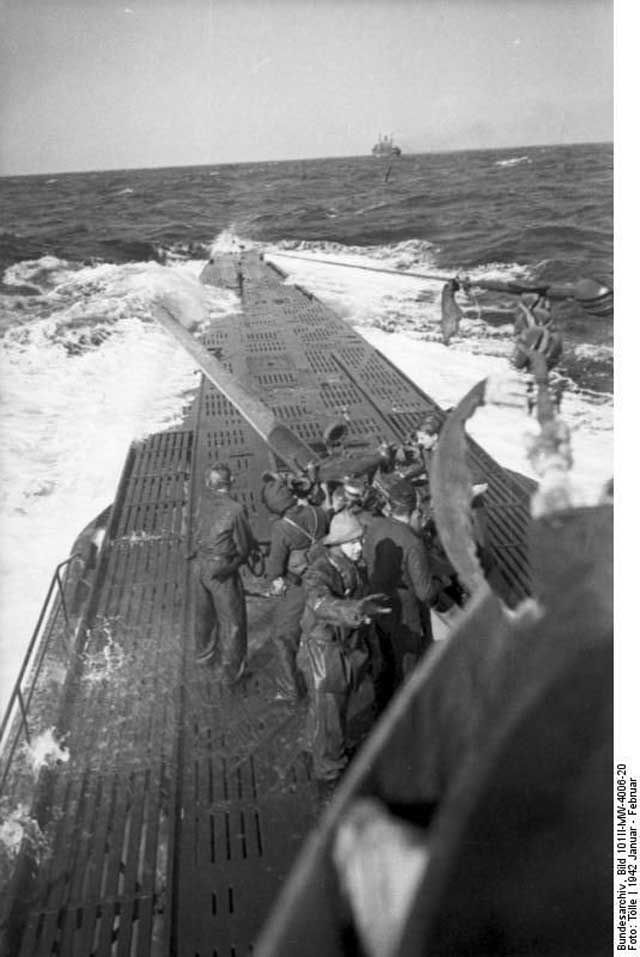
-
'Operation Shingle’
Anzio, Italy, 25 January 1944.
Sherman tanks of the 46th (Liverpool Welsh) Royal Tank Regiment provide fire support for men of the 1st Battalion, Loyal Regiment (North Lancashire).
Operation Shingle’ was finally launched on 22 January 1944, four days after a new US Fifth Army attack on the Garigliano and Rapido rivers near Cassino. British 1st Infantry Division under Major General Ronald Penney, supported by 46th Royal Tank Regiment and commandos of 2nd Special Service Brigade, landed north of Anzio. The US 3rd Infantry Division under Major General Lucian Truscott, supported by a tank battalion, three battalions of Rangers and an Airborne battalion, landed south of the port. Tactical surprise had been achieved and the landings were virtually unopposed. A handful of Luftwaffe aircraft got through the Allied fighter umbrella to strafe the ships, but the Allies lost only 13 men killed and 97 wounded. Anzio itself had been abandoned by the Germans and its civilian population moved out. Many German units had been deployed further south to counter US Fifth Army’s attack on the Garigliano. By the end of the day 36,000 troops and 3,200 vehicles had been delivered ashore. A US reconnaissance jeep patrol found the way open to Rome, and a bolder commander might well have taken advantage. But Major General John Lucas threw away the initiative, choosing instead to dig in and await the Germans.
(Ian Carter - IWM)
(Photo source -© IWM NA 11412)
Sgt. Menzies - No. 2 Army Film & Photographic Unit
-
yea too bad Patton wasn’t calling the shots. I get it that he shouldn’t have bitch slapped that soldier but he woulda saved a lot of lives by being aggressive. Of course he also wasted some by doing the same thing. In this instance it would’ve been justified imo
-
On this day in 1945, SSG Audie Murphy repelled a German attack all by himself, killing/wounding 50 German soldiers with a machine gun, firing from a burning M10 tank destroyer.
For his actions that day, he was awarded the Medal of Honor.
Picture is from the movie ‘To Hell and Back’ (1955). The soldier is Murphy himself, re-enacting the battle.
-
Gurkhas of the Fourteenth Army crossing the Irrawaddy, Burma on 27th January 1945 (IWM)
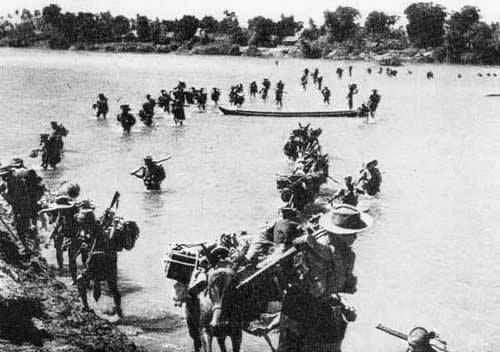
-
@captainwalker said in On this day during W.W. 2:
January 8th 1940 - Finland
Details of the Finnish victory over two Russian Divisions at Suomussalmi were released. The 44th Division was completely destroyed, trapped while going to the support of the defeated 163rd Division. The Finns captured 102 field guns, 43 tanks, over 300 vehicle and 1,170 horses.
On the night of 8th January in Helsinki the Church bells were ringing, flags were flying and strangers embraced on the streets in celebration.
Many Soviet tanks were burnt-out by Molotov cocktails thrown by Finns hiding in pits by the forest tracks, other Soviet troops froze to death with nothing to protect them from the cold except crude shelters of spruce branches.
When the Finns attacked some of the Soviet troops were too weak to stand, too cold to fight.
Picture shows Finnish soldiers preparing to tow a Soviet flamethrower tank OT-130. The OT-130 tank was based on the T-26 tank chassis, with the 45 mm gun replaced with a flamethrower.
Stop. I don’t need more pieces added to my game !!! Lol Sweet stuff as always.
-
January 28, 1942. Eastern Front
The unexpected success by a small German force to relieve the trapped garrison at Sukhinichi leads Adolf Hitler to begin dreaming of bigger successes. He asks the Second Panzer Army to convert the relief operation, which barely reached the town, to continue to the northeast toward a Fourth Army garrison at Yukhnov. This, at least theoretically, would trap a large Red Army force to the west. The plan bears remarkable similarities to Hitler’s desire to have Army Group North continue its advance past Tikhvin in November 1941. Second Panzer Army commander General Rudolf Schmidt has to explain to the Fuehrer that further advances are impossible until reinforcements arrive.
The Soviet Stavka (military command) creates the Crimean Front under Lieutenant General Dmitry Timofeyevich Kozlov. It includes the 44th, 47th, and 51st Armies. The Separate Coastal Army and Black Sea Fleet also come under Kozlov’s control. General Kozlov is inexperienced and has been hastily promoted from a regimental command, and his staff also is inexperienced. The Stavka sends Lev Mekhlis to Kozlov’s headquarters to help plan strategy, and the two agree to launch an offensive in mid-February to reconquer the entire Crimea. The Soviets in general and Kozlov, in particular, remain under the impression that the Red Army has military superiority in the Crimea when the opposite is true. In addition, the Kerch Peninsula has poor roads and the Luftwaffe has complete aerial superiority, making road movements in daylight extremely hazardous for the Soviets.
Photo: A Soviet KV-2 captured by the Germans and put into use on the Kalininsky front. 28 January 1942. The Germans would sometimes use captured tanks as “Beutepanzers” (“booty tanks”).
Source: worldwartwodaily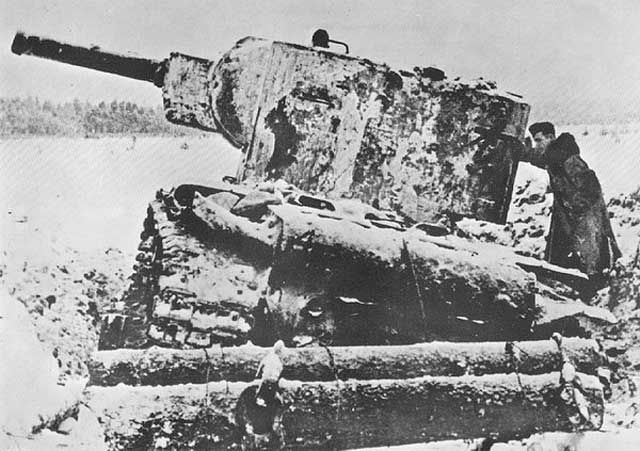
-
Thats a big fckn tank. Was the above one a Russian t-26 ?
-
@barnee In the earlier post, yes, with a flamethrower, replacing the 45mm cannon.
-
Ya barnee the Russians only built 330 K-V2s by end of war. Ya they were bad mobility and they were considered more of a SPA.
It had a 152 mm gun but since it wasn’t that great on movement and just sitting there the Germans Tank Destroyers could chew it up. It did make it in the Finland winter war same as the K-V1.
KV-1 was also built in 39 ( had issues too but better than any German tank at the time ) and on the Eastern front. But the KV-1 got better as the war went on. Had good traction in sand and snow. You could give them still move 2 ( while rest of motorized units can only move 1 in winter season if you have weather in your game. Then in 43 they made more of the IS-0 series tanks.I do have the KV-1s on the fronts in my game on setup. Game starting in Dec of 41 the KV-1s A6 D8 M2 for d12. Build 2 a turn only for 6 icps. Helps with Russian to defend Moscow and such. Just sayin.






